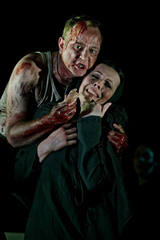| Opera Reviews | 8 May 2024 |
MacMillan's Inés de Castro makes for a night of horrorby Catriona Graham |
|
| MacMillan: Inés de Castro Scottish Opera January 2015 |
|
|
In Scottish Opera’s new production of James MacMillan’s 20-year-old opera, directed by Olivia Fuchs, there is no flinching from the horror of the events as they unfold. Kai Fischer’s set is as dark as the story, stripped to the essentials. For much of the opera, Inés’ orange-red dress and shawl are the only colour on stage, the others in shades of black and grey. Cordelia Chisholm’s costumes are generic second-half of the 20th century, the men in suits, or army fatigues. Even Bianca, the neglected wife of Pedro wears a silvery grey. There is colour aplenty, however, in the music and the singing. Between the opening Stabat Mater, low and dark, repeated brighter and more briskly as the men go to war at the end of Act 1, Inés (Stephanie Corley) sings of how she wants colour and joy in her life. When Pedro (Peter Wedd) visits her, the twining of their bodies mirrors the sensuous twining of their voices in the love-duet. Jo Clifford’s libretto does not spare us any details. Bianca (Susanna Glanville)’s description of the still and monstrous births she has endured is less mad than anguished and distraught.The voice of the Old Woman in white, personifying Death (Kathleen Wilkinson) seduces Inés from life and into the electric chair. As Pacheco, the King’s adviser, Paul Carey Jones keeps his voice almost colourless in its menace, except when he describes to Inés his traumatic experience as a child at the hands of the Spanish invaders. Executioner Gary Griffiths later relates Pacheco’s death in detail, with OHP illustrations. Brindley Sherratt vacillates as the aging King, in thrall to his adviser, who tricks him into signing the warrant for Inés’ death. Even his desire for death is half-hearted, till the Old Woman hands him the gun. The chorus, led by the Ordinary People (Rosalind Coad, Laura Margaret Smith, Ronan Busfield and Andrew McTaggart) have their best moments in Act 2, their disappointment at the standard of entertainment from the execution of Inés and the funeral of the king vividly portrayed, with dancing. With what the programme notes describe as ‘an enormous kitchen of percussion’, the orchestra responds well to the composer as conductor - the playing tight and precise, particularly the use of silence. Sometimes, however, the orchestra overwhelmed singers. At the end, with the corpse of Inés enthroned as his queen and the people forced to kiss her hand,Wedd leaves it ambiguous whether Pedro is mad with grief, or merely exercising his absolute kingly power. Into this macabre scene comes the pure voice of Georgia Dunn, as the Young Girl who alone sees the ghost of Inés, contrasting with all the richness of sound and tone which has gone before.
|
|
| Text ©
Catriona Graham Photo © Ken Dundas |

 Opera has been described as ‘the undoing of women’ and few women are as undone as Inés de Castro, Spanish mistress of Portuguese Crown Prince Pedro, and who was murdered as a threat to the state while he was absent fighting the Spanish invader.
Opera has been described as ‘the undoing of women’ and few women are as undone as Inés de Castro, Spanish mistress of Portuguese Crown Prince Pedro, and who was murdered as a threat to the state while he was absent fighting the Spanish invader.






